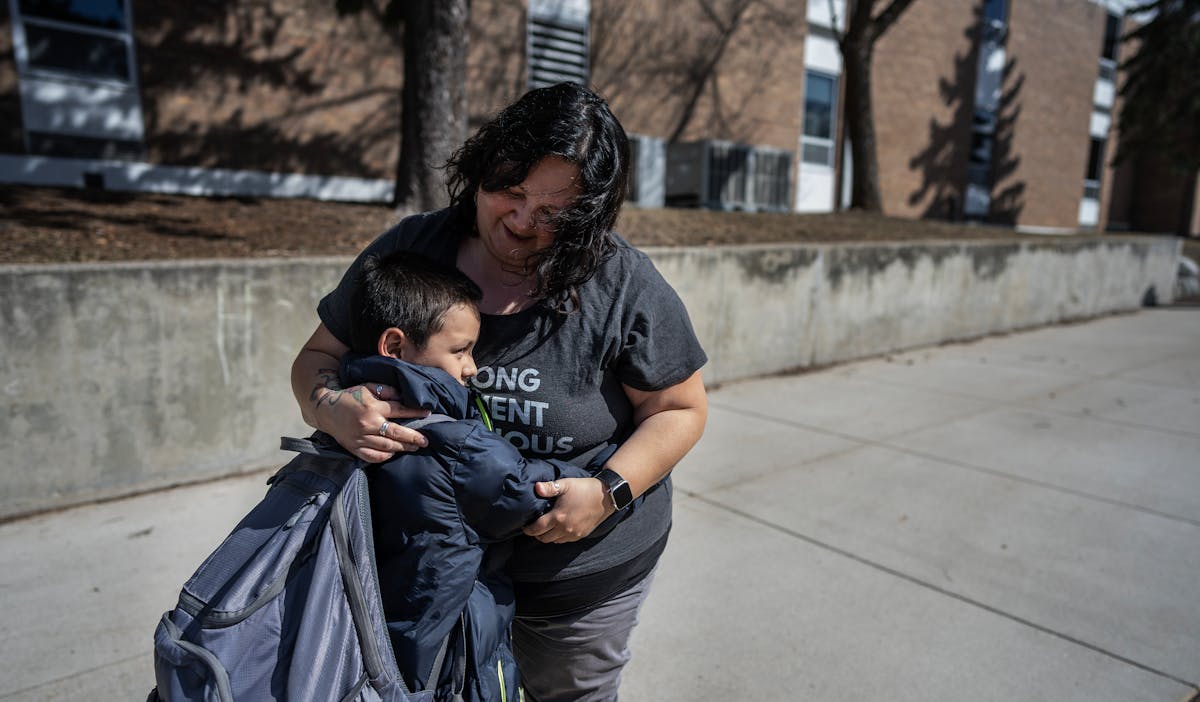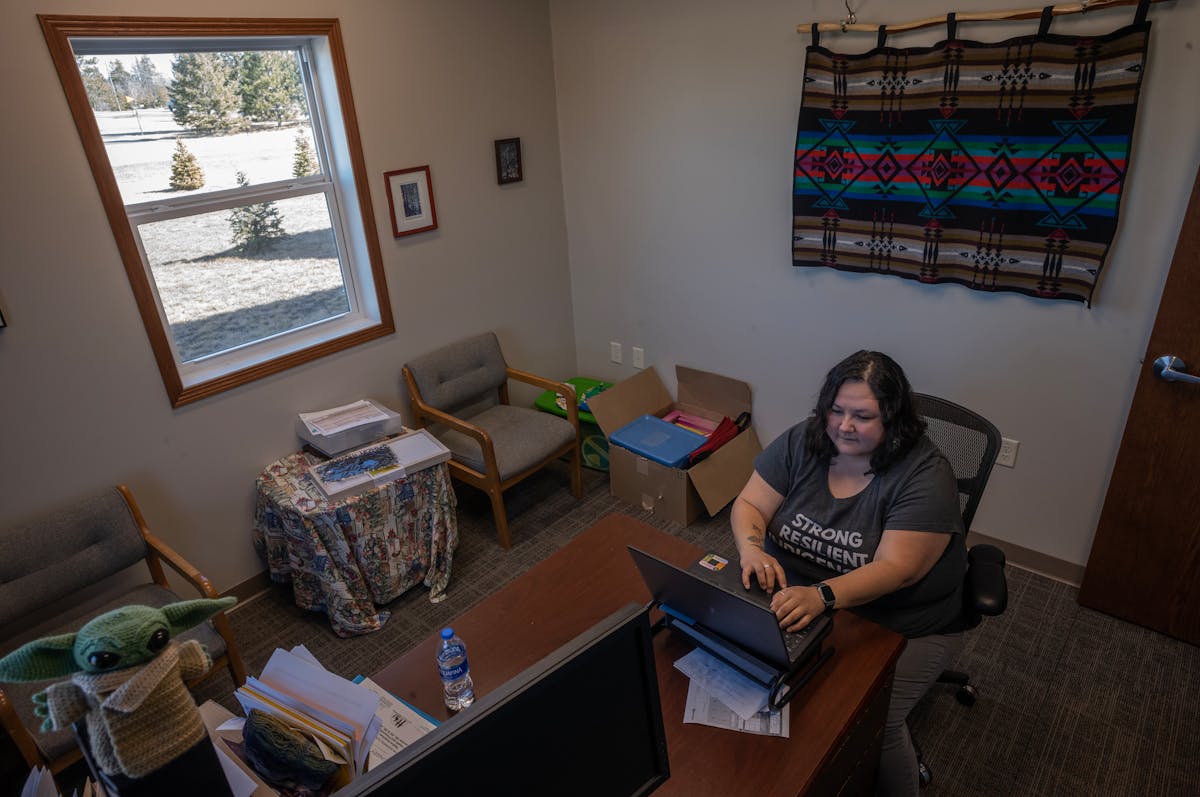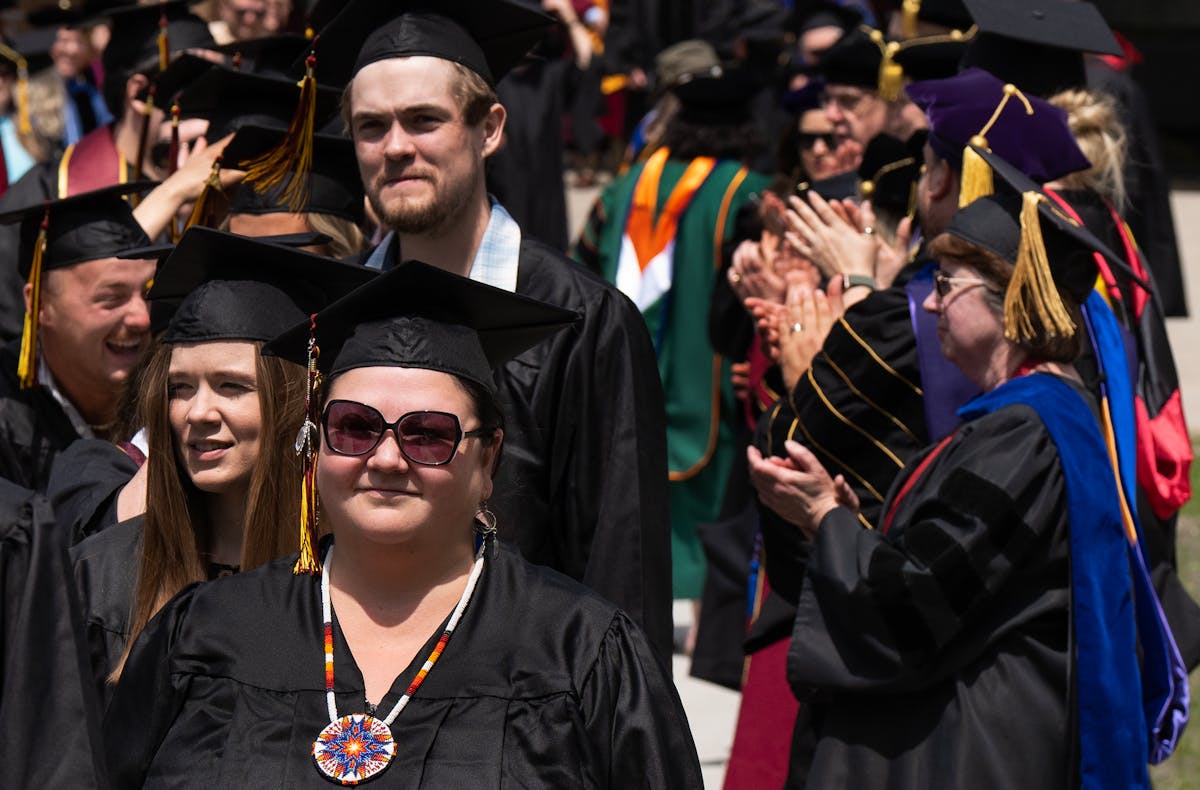WALKER, MINN. — Linsey McMurrin kicks the soccer ball to her son beneath the towering pines of northern Minnesota. Lots of kids play hockey around here in Walker. But McMurrin will be happy if her son, Tobias, stays off the ice.
"Hockey is expensive. They're traveling and staying every weekend in hotels," McMurrin said. "I'm grateful soccer is his thing."
For Native Americans like McMurrin in Minnesota, the economic story of recent decades is one of tenuous and fragile growth. Native American income was the fastest growing between 2005 and 2019, increasing 29% above the rate of inflation, according to new data the Federal Reserve Bank of Minneapolis compiled. Yet no other group remains as likely to fall down the economic ladder.
Matthew Gregg, a senior economist at the Center for Indian Country Development at the Minneapolis Fed, said the new data, while a revolutionary tool for researchers, didn't investigate the "mechanism" driving intergenerational poverty for American Indian and Alaska Natives (AIAN) people. He called the problem "multidimensional," but researchers often flag hallmark signs of income mobility — including schooling, housing and geography — that work against American Indians.
For people such as McMurrin, especially those living in tribal lands, the rarefied middle class remains elusive. Even when Indigenous earners in Minnesota reach the median income range for AIAN, they're still making $17,600 less than white earners.
Nevertheless, McMurrin, a citizen of the Leech Lake Band of Ojibwe, persists. She's the executive director of Peacemaker Resources, a Bemidji-based nonprofit building equity and cultural responsiveness in schools, and she owns her home in Walker, which she shares with her two sons. In seven years' time, she's moved from the 50th percentile of Native earners, making around $25,000, to cracking the 90th percentile earlier this year, making more than $66,040 annually.
But even on an early spring day, with the vivid blue of Leech Lake rising below her street, her financial footing feels both inspiring and precarious.
"There are many folks who work very hard, and because of the systems and policies, you hit, like, a ceiling," McMurrin said. "My grandma worked hard all her life. And we are still living paycheck-to-paycheck."
Job or family?
For many Native people who wish to achieve a middle-class existence near home, decent-paying, full-time jobs on the reservation or in border towns like Walker are limited to the school, casino or local and tribal government.
McMurrin's path started with an emphasis on education. Her single mom, a cafeteria cook-turned-paraprofessional at Walker-Hackensack-Akeley (WHA) schools, raised her. Her father, living across the bay in Onigum, was also a close presence.
By 13, she started working at Bieloh's Family Foods grocery store in Walker. After obtaining her driver's license, she waitressed at Moondance Ranch outside town. After high school, McMurrin went to the University of Minnesota, Morris, the site of a former Catholic boarding school that has long allowed Indigenous students to attend without paying tuition. But she dropped out a semester shy of graduating and moved back home to give birth to Isaias, her oldest son.
After years working at nonprofits, often stacking multiple part-time jobs together, McMurrin financed a house through Woodlands National Bank, which the Mille Lacs Band of Ojibwe in Onamia own. In 2022, she matriculated as Peacemaker's executive director. The boost in pay helped dramatically.
But at every step forward, she's experienced the restrictions of poverty-aid programs. With a higher salary, McMurrin was no longer eligible for reduced-cost health insurance through the state. When Isaias broke a finger in gym class this spring, rather than take him to the emergency room in Walker, she drove 25 minutes north to the Indian Health Service hospital in Cass Lake for care.
Even her house, which she purchased from a family member, is "too much house," in McMurrin's words. Plus, the basement floor to the laundry room is an unfinished dirt path. An aunt, a former real estate agent, encouraged her to sell the home and downsize. But as a first-time home buyers' loan recipient, she's obligated to maintain residence for a set number of years.
"There are these programs intended to help," McMurrin said. "But then they sometimes lock us in."


'Where you grow up matters'
According to national data, incomes for people living in tribal areas, including non-Natives, have fallen since 2013 relative to the overall economy.
The why of that, as Gregg said, often involves forces like education, shelter and location. Approximately 2 out of 3 American Indian children in Minnesota graduate high school within four years, according to state education data. At the college level, only 30% of American Indians or Alaska Natives achieve a postsecondary degree or certificate.
Underfunded schools have historically lacked cultural understandings to draw in students. Tribal housing, as another example, is often overcrowded.
"Where you grow up matters," Gregg said. "It matters especially if you're growing up in a low-income family on a reservation."
But there's a trade-off for Native Americans who remain near reservations: They're often closer to community, including spiritual and familial reservoirs.
Anton Treuer, professor of Ojibwe at Bemidji State University, said for many Native students, the road to financial stability — say, a job paying $65,000 — is off the reservation. Even as a professor with multiple publications, Treuer, too, knows potential employers who might pay more on the coasts. But he wishes to be close to home.
"I have relatives who've been buried in Bena, Minnesota, on the Leech Lake Reservation since long before America was a country," Treuer said on a March afternoon in his office overlooking Lake Bemidji. "Even though Natives live all over the place, and there's a big urban population, a lot of the cultural stuff is happening in these Native places."
Wealth-building post-colonialism
The Fed data reveals long-suspected inequalities for how different races, genders and even generations accumulate income in the American economy. But when it comes to helping AIAN communities build wealth, including through income growth, cultural misunderstandings or further ethnic erasure have marred governmental and nonprofit efforts.
Under the guise of private property rights, the Nelson Act of 1889 brought allotment to the "Chippewa Indians in the State of Minnesota," which led to the checkerboarding of reservations, such as Leech Lake. And through the assimilation of government-run boarding schools or the proselytizing of Christian aid groups on tribal lands, so-called "betterment" efforts draw heavy scrutiny today.
Still, some efforts are picking up excitement across Indian Country.
A U.S. Department of Agriculture rural housing home loan program that partners with Native-owned lenders has drawn early success in South Dakota and spread to other states, including Minnesota. Sen. Tina Smith has introduced a bill to permanently fund the program. And three years ago, the St. Paul-based Bush Foundation gifted $50 million to Rapid City, S.D.-based NDN Collective as seed money for grants to Native Americans to help them start building generational wealth.
Wicahpi "Star" Means, a program officer with NDN Collective and member of the Oglala Lakota Nation who grew up in Minneapolis, said tax documents reflect only a shadow of financial relationships for families hovering around the poverty line and often living with relatives for a year or more. She gave the example of a nephew currently living with her.
"That ain't going to show on last year's taxes, but this year?" Means said. "It definitely is a change in my household."
All involved say money is only part of the solution. Culture, religion and language, say advocates, also line the roadway to stability.
"Ceremonies are the most important piece," Means said. "For so long, we weren't able to practice that out in the open. But today, you can go down the block here on Haines and Anamosa and get in a sweat lodge."
The culture clash of capitalism and the collectivism embedded within many tribal teachings is a constant negotiation.
Back in Walker, McMurrin said at a former nonprofit, a white woman mentored an Anishinaabe boy. One day, the mentor told McMurrin she was frustrated the boy's dream was to go work for the casino.
"What wasn't being understood by the adult mentor," McMurrin said, "was [at the casino,] he can provide for his family. He can stay close and connected to community."
McMurrin said the mentor spoke with a "good heart," but added "it's frustrating that college and a high-paying job isn't what success means to everybody."

Close to home
On a Tuesday night in April at the Northern Lights Casino, teachers and staff at WHA school district sat in a conference room listening as an Ojibwe elder spoke about the Teachings of the Seven Grandfathers.
McMurrin, who helps run the American Indian Parent Advisory Committee at WHA, had helped organize the night for the school working to build ties between a largely white staff and a growing Native student population.
WHA Superintendent Kevin Wellen said he'd previously worked at the school in Cass Lake where more than 95% of the student body is Indigenous. In Walker, the student population is 26% Native. So that means there are "two cultures parallel" the community is trying to "get to understand each other," Wellen said.
Moreover, the tacit messaging Native students hear is they must divorce themselves from home to be successful. He notes Bemidji State University is 40 miles away. Other colleges are 100, 200 miles away. Then, when they have the bachelor's degree, the middle-class jobs are away from home, as well.
"Remember, [the message is] you have to leave your family," Wellen said. "But don't ask me: Ask Linsey. Family and the culture is everything."
For example, McMurrin had taken her sons to Seattle on a spring break road trip. After staying with a friend, they returned to Minnesota shortly before McMurrin's grandmother, who lives up the street, passed away.
Because McMurrin stayed home, tethered to her culture and family, she, Isais and Tobias will be close for the celebration of life.
"Even when I got this [executive director] position at Peacemaker, people were like, 'Oh, you are all moving to Bemidji now?'" McMurrin said. "And I'm like, 'No way. My entire family lives within a few-block radius.'"

